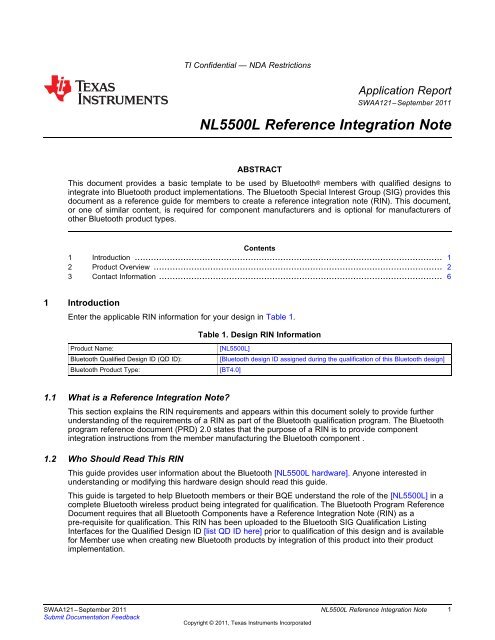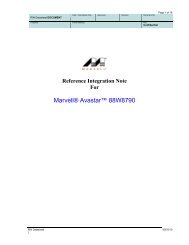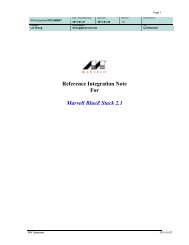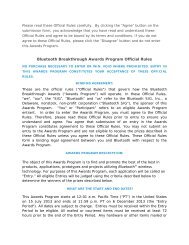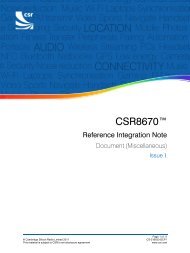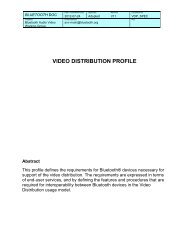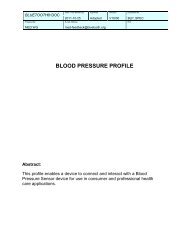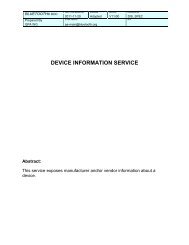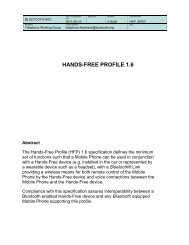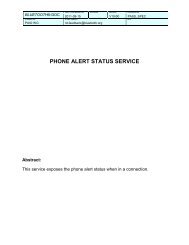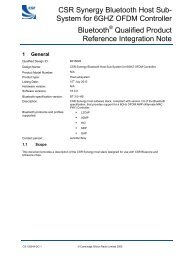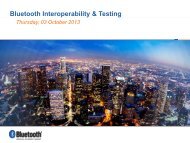NL5500L Reference Integration Note - Bluetooth
NL5500L Reference Integration Note - Bluetooth
NL5500L Reference Integration Note - Bluetooth
You also want an ePaper? Increase the reach of your titles
YUMPU automatically turns print PDFs into web optimized ePapers that Google loves.
TI Confidential — NDA RestrictionsApplication ReportSWAA121–September 2011<strong>NL5500L</strong> <strong>Reference</strong> <strong>Integration</strong> <strong>Note</strong>.....................................................................................................................................................ABSTRACTThis document provides a basic template to be used by <strong>Bluetooth</strong>® members with qualified designs tointegrate into <strong>Bluetooth</strong> product implementations. The <strong>Bluetooth</strong> Special Interest Group (SIG) provides thisdocument as a reference guide for members to create a reference integration note (RIN). This document,or one of similar content, is required for component manufacturers and is optional for manufacturers ofother <strong>Bluetooth</strong> product types.Contents1 Introduction .................................................................................................................. 12 Product Overview ........................................................................................................... 23 Contact Information ......................................................................................................... 61 IntroductionEnter the applicable RIN information for your design in Table 1.Table 1. Design RIN InformationProduct Name:<strong>Bluetooth</strong> Qualified Design ID (QD ID):<strong>Bluetooth</strong> Product Type:[<strong>NL5500L</strong>][<strong>Bluetooth</strong> design ID assigned during the qualification of this <strong>Bluetooth</strong> design][BT4.0]1.1 What is a <strong>Reference</strong> <strong>Integration</strong> <strong>Note</strong>?This section explains the RIN requirements and appears within this document solely to provide furtherunderstanding of the requirements of a RIN as part of the <strong>Bluetooth</strong> qualification program. The <strong>Bluetooth</strong>program reference document (PRD) 2.0 states that the purpose of a RIN is to provide componentintegration instructions from the member manufacturing the <strong>Bluetooth</strong> component .1.2 Who Should Read This RINThis guide provides user information about the <strong>Bluetooth</strong> [<strong>NL5500L</strong> hardware]. Anyone interested inunderstanding or modifying this hardware design should read this guide.This guide is targeted to help <strong>Bluetooth</strong> members or their BQE understand the role of the [<strong>NL5500L</strong>] in acomplete <strong>Bluetooth</strong> wireless product being integrated for qualification. The <strong>Bluetooth</strong> Program <strong>Reference</strong>Document requires that all <strong>Bluetooth</strong> Components have a <strong>Reference</strong> <strong>Integration</strong> <strong>Note</strong> (RIN) as apre-requisite for qualification. This RIN has been uploaded to the <strong>Bluetooth</strong> SIG Qualification ListingInterfaces for the Qualified Design ID [list QD ID here] prior to qualification of this design and is availablefor Member use when creating new <strong>Bluetooth</strong> products by integration of this product into their productimplementation.SWAA121–September 2011Submit Documentation FeedbackCopyright © 2011, Texas Instruments Incorporated<strong>NL5500L</strong> <strong>Reference</strong> <strong>Integration</strong> <strong>Note</strong>1
TI Confidential — NDA RestrictionsProduct Overviewwww.ti.com1.3 What This RIN ContainsThis section describes the contents of the RIN, including• Product overview• Product features• Detailed description of the hardware and/or software design• Bill of materials• Schematics showing the electrical architecture of the product hardware design, etc.2 Product OverviewThe <strong>NL5500L</strong> is a single-chip device that fully integrates the functions of a global positioning system(GPS) unit, <strong>Bluetooth</strong> technology, and FM (RX and TX) capabilities. This device integrates advancedpower management functions and includes an on-chip low-noise amplifier (LNA) for the GPS and<strong>Bluetooth</strong> functions along with an integrated <strong>Bluetooth</strong> Class 1.5 power amplifier (PA). This chip isdesigned using the advanced 65-nm CMOS process node to provide significant power savings.Additionally, it leverages TI’s digital radio processor ( DRP) technology for high-efficiency radiofrequency (RF) design. This unit offers a best-in-class solution size with minimal external components fora complete system design.The device architecture simplifies GPS/<strong>Bluetooth</strong>/FM implementation on a cellular platform throughsupport for multifunction coexistence scenarios and shared host interfaces. The <strong>NL5500L</strong> supportspractical use cases, such as simultaneous operation of two or more functionalities, and overcomescoexistence issues. The <strong>NL5500L</strong> system architecture uses techniques such as dynamic frequencyinterference avoidance to overcome typical coexistence and interference issues, and ensures that theproduct maintains optimal performance with little or no degradation in the presence of interference. Inaddition, the interface-sharing approach between the GPS, <strong>Bluetooth</strong>, and FM segments is implementedto reduce overall pin count and interfaces on the host. Host interface backward-compatibility with theNL5350 and the BL6450 from TI is retained for platform migration to the <strong>NL5500L</strong> and host softwarereuse.The GPS core offered in the <strong>NL5500L</strong> is a sixth-generation GPS next to the NL5350 of TI’s GPSsingle-chip receiver devices. Enhancements in the GPS core help reduce the time-to-first-fix (TTFF)significantly at low signal power levels to provide the user with a high-quality GPS experience.Improvements in acquisition performance help the user obtain fixes in deep indoor conditions.Architectural enhancements in tracking performance minimize errors in multipath and deep indoorenvironments. The NL5500 incorporates advanced power-management schemes; the device intelligentlyturns off parts of the GPS core when not required in periods between location fixes. The GPS solutionfrom TI supports integration with external sensors and the corresponding software support to improve theGPS performance in deep urban canyon locations, for dead reckoning and pedestrian navigation.The <strong>Bluetooth</strong> core is based on the BL6450 device, which is the fifth generation of TI's single-chip<strong>Bluetooth</strong> solution. It is a highly integrated core that forms a complete <strong>Bluetooth</strong> v4.0 wirelesscommunication system, supporting the physical layer and up to the host controller interface (HCI) layer.The core provides a complete hardware and software solution for <strong>Bluetooth</strong>. As <strong>Bluetooth</strong>, GPS, and FMfunctions are integrated on the same silicon, the solution offers optimal RF coexistence.The FM function offers state-of-the-art performance for all critical FM parameters, such as currentconsumption, stereo signal-to-noise ratio (SNR), and sensitivity. The FM core supports FM transmissionwith operating frequencies from 76 to 108 MHz, including a programmable gain power amplifier with levelscompliant to ETSI EN 300 328, EN 300 328-2, and FCC part 15, as well as higher power levels. It alsoincludes both FM analog and digital (I2S/PCM) data interfaces, supporting voice quality sample rate andMP3 audio quality sample rates.2 <strong>NL5500L</strong> <strong>Reference</strong> <strong>Integration</strong> <strong>Note</strong> SWAA121–September 2011Submit Documentation FeedbackCopyright © 2011, Texas Instruments Incorporated
TI Confidential — NDA Restrictionswww.ti.com2.1 Hardware FeaturesProduct Overview2.1.1 Product Type DeclarationThis product is listed as a <strong>Bluetooth</strong> component product. If you use this product to implement <strong>Bluetooth</strong> inyour product design, further qualification and listing is required in accordance with the <strong>Bluetooth</strong>qualification process (see PRD 2.0). To start the process for a new qualification, seehttps://bluetooth.org/TPG/.2.1.2 Standard Operating ConditionsTable 2. Standard Operating Conditions (1)PARAMETER (2) NL5500 UNITSupply voltage range VBAT1 (3) –0.5 to 5.5 VVDDS –0.5 to 2.1 VInput voltage to input pins (4) –0.5 to 2.1 VInput voltage to all other pins –0.5 to (VDDS + 0.5) VOperating ambient temperature range –40 to +85 °CStorage temperature range –55 to +125 °C(1)Stresses above these ratings may cause permanent damage. Exposure to absolute maximum conditions for extended periodsmay degrade device reliability. These are stress ratings only, and functional operation of the device at these or any otherconditions beyond those indicated under recommended operating conditions is not implied. Exposure toabsolute-maximum-rated conditions for extended periods may affect device reliability.(2)All parameters are measured as follows unless stated otherwise: VBAT1 = 3.6 V, VDDS = 1.8 V.(3)Maximum allowed depends on accumulated time at that voltage: 4.8 V continuous, 5.5 V for 1 second.(4)Analog pins: BTRF, GPS_LNA_IN, FM_RF_OUT, FM_RF_IN, FM_AUDI/O_I/O, TCXO_CLK _LV, REF_CLK_LV2.1.3 ApplicationThe design is most likely to be used or targeted for notebook PCs, mobile phones, peripherals, PDAs, andPNDs (see Section 2.1.4, Design Block Diagram).2.1.4 Design Block DiagramGPS RFandanalog<strong>Bluetooth</strong> RFandanalogFM RFandanalogDigitalhardwareDigitalhardwareDigitalhardwareGPS FWBTPHY FWBTMAC FWFM FWPower-on resetclock managerRegister bankand mailboxMux andI/O controllerPower-management systemClock managerSWAA121-001SWAA121–September 2011Submit Documentation FeedbackCopyright © 2011, Texas Instruments Incorporated<strong>NL5500L</strong> <strong>Reference</strong> <strong>Integration</strong> <strong>Note</strong>3
TI Confidential — NDA RestrictionsProduct Overviewwww.ti.com2.1.5 Hardware Features• GPS features– Very short TTFF at low signal power levels through enhanced receiver core architecture providesthe consumer with a compelling GPS experience.– Improved acquisition performance to process position fixes in deep indoor conditions– Reduced power consumption though improvements to RF architecture, software techniques,receiver core, and RF noise figure partitioning– Improved tracking performance and minimized error in multipath environments through increased IFBW and higher sampling rates in tracking channels– Sensor integration support to enhance GPS solution performance in deep urban canyon locations– Enhanced power-management schemes: the NL5500 intelligently turns off portions of the GPS corewhen not required between location fixes.• <strong>Bluetooth</strong> features– Support of <strong>Bluetooth</strong> 4.0 up to HCI level – BLE (10 multiple BLE connections)– Very fast AFH algorithm for ACL and eSCO– Supports typically 12.5 dBm Class 1.5 TX power without external PA, improving the robustness ofthe <strong>Bluetooth</strong> link– Supports multiple <strong>Bluetooth</strong> and FM profiles with enhanced QoS – FMoBT both mono and stereo,assisted A2DP (no host processing required)– Spurious emissions compatible with GPS applications– Internal temperature detection and compensation ensures minimal variation in the RF performanceover temperature.– Flexible PCM and I2S digital audio/voice interfaces: Full flexibility of data format (Linear, a-Law,m-Law), data width, data order, sampling and slot positioning, master/slave modes, high clock ratesup to 16 MHz for slave mode (or 6 MHz for master mode). Lost packet concealment for improvedaudio.2.1.6 Radio ModulesThe radio module is a DRP, single-ended, 50-Ω I/O for easy RF interfacing.2.1.7 InterfacesFigure 1 shows the design interfaces.4 <strong>NL5500L</strong> <strong>Reference</strong> <strong>Integration</strong> <strong>Note</strong> SWAA121–September 2011Submit Documentation FeedbackCopyright © 2011, Texas Instruments Incorporated
TI Confidential — NDA Restrictionswww.ti.comProduct OverviewBattery/extregulatorsupply(VBAT/Vreg)VIO supply(VIO/VD DS) TCXO_CLK REF_CLK RTC_CLKPower supplyClocksJTAG I/FDFT I/FDebug busExternalmemory I/FBT and GPSdebug TXUARTsGPIOBT-wLANcoex I/FBT GSM/hostsync/ GPSPA BLANKDebug/DFT interfacesExternal interface<strong>Bluetooth</strong>MACModemDRPbBT class1 I/F BT IP FM IPTop-level service blocksControlblockModum(DBB,RDS,ST DEC)TX/RXAFEGPSreceivercoreGPS IPGPSRFBT host/ audiointerfaceDRPbinterfaceFM TX/RXinterfaceBT HCI UART /or(SPI + BT_IRQ)BT voice I/F(I2S/PCM)BT deep sleepprotocalBT RX/TXantennaBT LDOoutputsBT analogtestFM RXantennaFM TXantennaFM LDOoutputsFM analogtestPower/clockcontrol interfacesGPS hostinterfacesGPS RFinterfaceFM host control and audiointerfacesClockrequestsClockrequestpolarityToplevelLDOoutputsBTandGPSshutdownUART/I 2 Chost I/Fand IRQ2I CmasterI/FGPScontrolI/FGPS GPSRF In LDOoutputs2FM I CandFM IRQFigure 1. Design InterfacesFMaudiodigital I/F(PCM/I2S)FM RXaudioanalogoutputsFM TXaudioanaloginputsswaa121-0022.1.8 Application RequirementsThe <strong>NL5500L</strong> is suitable for various operating systems,such as Android and Symbian Windows, andcontains all of the common interfaces in the market. It is also suitible for platforms, such as PNDs,smartphones, and tablets, and supports all configurations, such as HCILL and shared UART transport.More detailed application paper can be supplied under NDA.SWAA121–September 2011Submit Documentation FeedbackCopyright © 2011, Texas Instruments Incorporated<strong>NL5500L</strong> <strong>Reference</strong> <strong>Integration</strong> <strong>Note</strong>5
TI Confidential — NDA RestrictionsContact Informationwww.ti.com2.1.9 Bill of MaterialsSr No Value Quantity Part <strong>Reference</strong> Manufacturer Part Number Package1 NL5500 WSP 1 U1 TI NL5500 4.35 mm × 4.6 mm2 TXCO 1 TCXO1 Kyocera KT2016 2.0 mm × 1.6 mm3 GPS SAW Filter 1 FL1 EPCOS B9080 2.0 mm × 1.6 mmLFB212G45CC2D011TEM4 <strong>Bluetooth</strong> Filter 1 FL2 Murata 2.0 mm × 1.6 mmPC1 C2 C3 C45 0.1 µF 10 C10 C11 C12 Murata GRM155R71C104KA88D EIA-0402C24 C25 C266 1 µF 4 C5 C21 C27 C28 Murata GRM155R61A105KE15D EIA-04027 1 pF 1 C7 Murata GJM1555C1H1R0CB01D EIA-04028 22 pF 2 C8 C20 Murata GRM1555C1H220JZ01D EIA-0402C11 C12 C139 0.22 µF 7 C15 C16 C18 Murata GRM155R61A224KE19D EIA-0402C1910 68 pF 1 C22 Murata GRM1555C1H680JZ01D EIA-040211 1 nF 1 C23 Murata GRM1555C1H102JA01D EIA-040212 12 nH 1 L1 Taiyo Yuden HK100512NJ-T EIA-040213 180 nH 1 L2 Murata LQG15HSR18J02D EIA-04023 Contact Informationsaket@ti.comThukral, Saket6 <strong>NL5500L</strong> <strong>Reference</strong> <strong>Integration</strong> <strong>Note</strong> SWAA121–September 2011Submit Documentation FeedbackCopyright © 2011, Texas Instruments Incorporated
IMPORTANT NOTICETexas Instruments Incorporated and its subsidiaries (TI) reserve the right to make corrections, modifications, enhancements, improvements,and other changes to its products and services at any time and to discontinue any product or service without notice. Customers shouldobtain the latest relevant information before placing orders and should verify that such information is current and complete. All products aresold subject to TI’s terms and conditions of sale supplied at the time of order acknowledgment.TI warrants performance of its hardware products to the specifications applicable at the time of sale in accordance with TI’s standardwarranty. Testing and other quality control techniques are used to the extent TI deems necessary to support this warranty. Except wheremandated by government requirements, testing of all parameters of each product is not necessarily performed.TI assumes no liability for applications assistance or customer product design. Customers are responsible for their products andapplications using TI components. To minimize the risks associated with customer products and applications, customers should provideadequate design and operating safeguards.TI does not warrant or represent that any license, either express or implied, is granted under any TI patent right, copyright, mask work right,or other TI intellectual property right relating to any combination, machine, or process in which TI products or services are used. Informationpublished by TI regarding third-party products or services does not constitute a license from TI to use such products or services or awarranty or endorsement thereof. Use of such information may require a license from a third party under the patents or other intellectualproperty of the third party, or a license from TI under the patents or other intellectual property of TI.Reproduction of TI information in TI data books or data sheets is permissible only if reproduction is without alteration and is accompaniedby all associated warranties, conditions, limitations, and notices. Reproduction of this information with alteration is an unfair and deceptivebusiness practice. TI is not responsible or liable for such altered documentation. Information of third parties may be subject to additionalrestrictions.Resale of TI products or services with statements different from or beyond the parameters stated by TI for that product or service voids allexpress and any implied warranties for the associated TI product or service and is an unfair and deceptive business practice. TI is notresponsible or liable for any such statements.TI products are not authorized for use in safety-critical applications (such as life support) where a failure of the TI product would reasonablybe expected to cause severe personal injury or death, unless officers of the parties have executed an agreement specifically governingsuch use. Buyers represent that they have all necessary expertise in the safety and regulatory ramifications of their applications, andacknowledge and agree that they are solely responsible for all legal, regulatory and safety-related requirements concerning their productsand any use of TI products in such safety-critical applications, notwithstanding any applications-related information or support that may beprovided by TI. Further, Buyers must fully indemnify TI and its representatives against any damages arising out of the use of TI products insuch safety-critical applications.TI products are neither designed nor intended for use in military/aerospace applications or environments unless the TI products arespecifically designated by TI as military-grade or "enhanced plastic." Only products designated by TI as military-grade meet militaryspecifications. Buyers acknowledge and agree that any such use of TI products which TI has not designated as military-grade is solely atthe Buyer's risk, and that they are solely responsible for compliance with all legal and regulatory requirements in connection with such use.TI products are neither designed nor intended for use in automotive applications or environments unless the specific TI products aredesignated by TI as compliant with ISO/TS 16949 requirements. Buyers acknowledge and agree that, if they use any non-designatedproducts in automotive applications, TI will not be responsible for any failure to meet such requirements.Following are URLs where you can obtain information on other Texas Instruments products and application solutions:ProductsApplicationsAudio www.ti.com/audio Communications and Telecom www.ti.com/communicationsAmplifiers amplifier.ti.com Computers and Peripherals www.ti.com/computersData Converters dataconverter.ti.com Consumer Electronics www.ti.com/consumer-appsDLP® Products www.dlp.com Energy and Lighting www.ti.com/energyDSP dsp.ti.com Industrial www.ti.com/industrialClocks and Timers www.ti.com/clocks Medical www.ti.com/medicalInterface interface.ti.com Security www.ti.com/securityLogic logic.ti.com Space, Avionics and Defense www.ti.com/space-avionics-defensePower Mgmt power.ti.com Transportation and Automotive www.ti.com/automotiveMicrocontrollers microcontroller.ti.com Video and Imaging www.ti.com/videoRFIDOMAP Mobile ProcessorsWireless Connctivitywww.ti-rfid.comwww.ti.com/omapwww.ti.com/wirelessconnectivityTI E2E Community Home Pagee2e.ti.comMailing Address: Texas Instruments, Post Office Box 655303, Dallas, Texas 75265Copyright © 2011, Texas Instruments Incorporated


